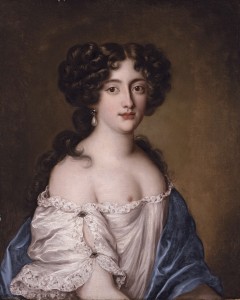by Elizabeth C. Goldsmith, Regular Contributor
 When Cardinal Mazarin, prime minister of France died in 1660, on his deathbed he settled a marriage contract for his 15-year-old niece Hortense Mancini. Her betrothed was a religious fanatic over twice her age, whose only passion other than prayer and zealotry was a jealous possessiveness of his beautiful young wife. The Cardinal bequeathed a fortune and also his name to the couple, leaving Hortense, in her own words, “the richest heiress and the unhappiest woman in Christendom.”
When Cardinal Mazarin, prime minister of France died in 1660, on his deathbed he settled a marriage contract for his 15-year-old niece Hortense Mancini. Her betrothed was a religious fanatic over twice her age, whose only passion other than prayer and zealotry was a jealous possessiveness of his beautiful young wife. The Cardinal bequeathed a fortune and also his name to the couple, leaving Hortense, in her own words, “the richest heiress and the unhappiest woman in Christendom.”
During the 7 years that she remained with her husband, the young Duchess Mazarin produced 4 children and submitted to Armand’s jealous rages, as he dragged her along with him on trips to his distant properties and then locked her up at home when they returned to Paris. Then she decided to try to obtain a legal separation. Failing in that attempt, she ran away, leaving her children behind. From the day she hit the road in June 1667, she was a celebrity. Her escapades and travels were followed with great interest by readers of the news gazettes that were then popping up all over Europe. It was assumed that she had taken a lover, for why else would a woman leave such wealth behind? (Leaving the children didn’t inspire much commentary.) The exiled courtier Bussy-Rabutin, famous for his running observations on court intrigue, wrote that “no cuckold has ever been so deserving of the title as the Duke Mazarin, and every day of his life gives me more admiration for his wife, who prefers to take to the road rather than suffer his presence any longer.”
On the road she encountered bandits, avoided pursuers, crossed paths for awhile with other runaway women, and learned to exploit the anonymity of a system of public conveyance via postal coach, newly introduced in France. She took refuge with sympathetic noblemen such as the powerful Duke Charles-Emmanuel of Savoy, who was enchanted with her and cared little for threats coming from France and Italy demanding that she be returned to her husband. When she was forced to leave Savoy after Charles-Emmanuel’s death in 1675, she traveled – in winter! – through Switzerland, Germany, and Holland. She narrowly escaped shipwreck in the English channel and made her way to London, where her second cousin, Mary of Modena, was wife to the king’s brother. She immediately attracted the notice of King Charles II and became his mistress.
Meanwhile her morose French husband had lost none of his jealous desire to make her come back to him. In 1689, over twenty years after his wife had left him, the Duke Mazarin brought suit against Hortense to force her to give up her libertine lifestyle and return to France to resume conjugal life. He may have thought the time propitious – Hortense had lost the pensions that had been awarded to her by King Charles II, who had died in 1685. The decision of the law court came down in favor of the Duke, but Hortense stayed in London and refused to change her habits or reject her epicurean friends. She remained in England for another nine years, heavily indebted, until her death in 1699.
As a runaway wife in exile, Hortense had always been in the news, and in death her very moveable body continued to receive attention. Some of her creditors, hoping to recover their losses from her family in France, successfully laid claim to her corpse and demanded payment. And after all those years of refusing to send her money and trying to force his indigent wife’s return, the Duke Mazarin decided to pay up. He negotiated a settlement, delivering the sum in person to London.
But while it was expected that he would bring his wife home to a family sepulcre, crazy Armand had other ideas. He paraded her body around France, from Alsace to Brittany, to precisely those properties that she had so detested visiting in the early years of their marriage. Was he carrying out his revenge on Hortense’s celebrated ability to travel where and when she pleased? Slowly and ceremoniously he transported the casket to each of his provincial estates before finally, four months later, allowing himself to be persuaded to bury her.
For further reading:
The Memoirs of Hortense and Marie Mancini, edited and translated by Sarah Nelson (2007).
Elizabeth C. Goldsmith, The Kings’ Mistresses: The Liberated Lives of Marie Mancini, Princess Colonna and her Sister Hortense, Duchess Mazarin (2012).

